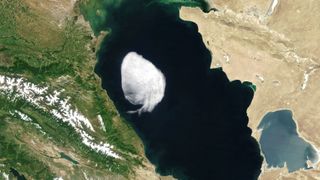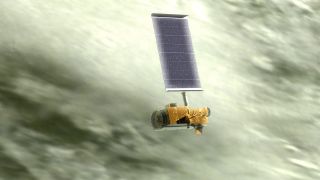Strange cloud in satellite data catches interest of scientists
The small stratocumulus cloud has a complex origin story.

A "peculiar" cloud, as NASA terms it, was found over the Caspian Sea on May 28. The cloud offers an interesting case study of how satellites can detect such phenomena in Earth's atmosphere.
Scientists used NASA's Terra satellite to watch the cloud as it moved towards land and then dissipated in order to learn more about how small stratocumulus features like this one form.
Stratocumulus clouds tend to be clumped together at low altitudes in the atmosphere; this one was spotted at about 1,500 meters (5,000 feet) above Earth's surface. What made it really stand out in new images captured by Terra's Moderate Resolution Imaging Spectroradiometer (MODIS), however, was the cloud's hard boundary.
Related: Satellite spies gigantic 'fuzzball' clouds spreading near Australia coast
"Sharp edges are often formed when dry, warm air coming from land collides with colder moist air over the ocean, and the cloud forms at that boundary," Bastiaan van Diedenhoven, an atmospheric scientist at SRON Netherlands Institute for Space Research, said in a NASA statement posted June 16.
It's unusual to see this type of cloud in Eastern Europe, as opposed to over an ocean area, although its appearance could be explained by the Caspian Sea being the world's largest inland body of water. The sea is surrounded by countries such as Kazakhstan, Iran, Turkmenistan, Georgia and Azerbaijan, to name a few.
"You often see this [cloud type] off the west coast of Africa, but at much larger scales," van Diedenhoven added. He suggested the cloud could have formed when warmer, drier air that possibly came from the Balkans (the area around Greece) hit colder and moister air over the Caspian Sea.
Get the Space.com Newsletter
Breaking space news, the latest updates on rocket launches, skywatching events and more!

The cloud began to dissipate in the hours after it was captured in the late morning over the Caspian. By the afternoon it had moved northwest over the sea to the coast of Russia, near Makhachkala at the foothills of the Caucasus Mountains. The cloud eventually dissipated completely as it moved over land.
Terra is an extremely long-running Earth observation mission, having launched in December 1999 and continuing to operate in good health as it approaches the quarter-century mark in space.
—
—
—
The benefit of long missions like Terra is they allow researchers to track changes in the Earth's environment using the same sensors, allowing for measurement consistency. That said, NASA and the National Oceanic Atmospheric Administration (NOAA) do send new satellites aloft to capture different types of measurements — and to serve as a bit of redundancy for older missions.
Earlier in the year, NASA's science and Earth science lead, Katherine Calvin, said the agency is working on a more comprehensive plan to refresh its fleet of older satellites, like Terra. Other examples of older operational missions include Aqua (launched in 2002) and Aura (2004).
Follow Elizabeth Howell on Twitter @howellspace. Follow us on Twitter @Spacedotcom or Facebook.
Join our Space Forums to keep talking space on the latest missions, night sky and more! And if you have a news tip, correction or comment, let us know at: community@space.com.

Elizabeth Howell (she/her), Ph.D., is a staff writer in the spaceflight channel since 2022 covering diversity, education and gaming as well. She was contributing writer for Space.com for 10 years before joining full-time. Elizabeth's reporting includes multiple exclusives with the White House and Office of the Vice-President of the United States, an exclusive conversation with aspiring space tourist (and NSYNC bassist) Lance Bass, speaking several times with the International Space Station, witnessing five human spaceflight launches on two continents, flying parabolic, working inside a spacesuit, and participating in a simulated Mars mission. Her latest book, "Why Am I Taller?", is co-written with astronaut Dave Williams. Elizabeth holds a Ph.D. and M.Sc. in Space Studies from the University of North Dakota, a Bachelor of Journalism from Canada's Carleton University and a Bachelor of History from Canada's Athabasca University. Elizabeth is also a post-secondary instructor in communications and science at several institutions since 2015; her experience includes developing and teaching an astronomy course at Canada's Algonquin College (with Indigenous content as well) to more than 1,000 students since 2020. Elizabeth first got interested in space after watching the movie Apollo 13 in 1996, and still wants to be an astronaut someday. Mastodon: https://qoto.org/@howellspace
